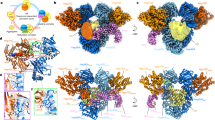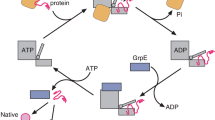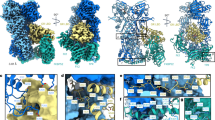Abstract
DURING their transit through the endoplasmic reticulum, newly synthesized light and heavy chains of immunoglobulins associate with two endoplasmic reticulum stress proteins. BiP/GRP78, a member of the HSP70 family, binds these polypeptides, presumably through promiscuously exposed hydrophobic sequences1,2, soon after their translocation into the endoplasmic reticulum3,4. GRP94, another endoplasmic reticulum stress protein5,6 homologous to HSP907–11, also associates with unassembled immunoglobulin chains12, but its interaction is biochemically, kinetically and structurally distinct from BiP's. We report here that whereas BiP preferentially binds an early disulphide intermediate of light chain and dissociates within a few minutes, GRP94 exclusively binds fully oxidized molecules and dissociates with a half-time of 50 min. These results indicate that GRP94 is itself a chaperone which acts after BiP.
This is a preview of subscription content, access via your institution
Access options
Subscribe to this journal
Receive 51 print issues and online access
$199.00 per year
only $3.90 per issue
Buy this article
- Purchase on Springer Link
- Instant access to full article PDF
Prices may be subject to local taxes which are calculated during checkout
Similar content being viewed by others
References
Flynn, G. C. et al. Nature 353, 726–730 (1991).
Blond-Elguindi, S. et al. Cell 75, 717–728 (1993).
Bole, D. G., Hendershot, L. M. & Kearney, J. F. J. Cell Biol. 102, 1558–1566 (1986).
Knittler, M. R. & Haas, I. G. EMBO J. 11, 1573–1581 (1992).
Lee, A. S. Trends biochem. Sci. 12, 20–23 (1987).
Lee, A. S. et al. J. biol. Chem. 258, 597–603 (1983).
Sorger, P. K. & Pelham, H. R. B. J. molec. Biol. 194, 341–344 (1987).
Mazzarella, R. A. & Green, M. J. biol. Chem. 262, 8875–8883 (1987).
Koch, G. et al. J. Cell Sci. 86, 217–232 (1986).
Gething, M.-J. & Sambrook, J. Nature 355, 33–45 (1992).
Li, Z. & Srivastava, P. K. EMBO J. 12, 3143–3151 (1993).
Melnick, J., Aviel, S. & Argon, Y. J. biol. Chem. 267, 21303–21306 (1992).
Schaiff, W. T. et al. J. exp. Med. 176, 657–666 (1992).
Navarro, D., Qadri, I. & Pereira, L. Virology 184, 253–264 (1991).
Scherrer, L. C. et al. J. biol. Chem. 265, 21397–21400 (1990).
Munro, S. & Pelham, H. R. B. Cell 46, 291–300 (1986).
Nadeau, K., Das, A. & Walsh, C. T. J. biol. Chem. 268, 1479–1487 (1993).
Clairmont, C. A., De Maio, A. & Hirschberg, C. B. J. biol. Chem. 267, 3983–3990 (1992).
Whelan, S. A. & Hightower, L. E. J. Cell Physiol. 125, 251–258 (1985).
Lin, H.-y. et al. Molec. Biol. Cell 4, 1109–1119 (1993).
Wu, G. E., Hozumi, N. & Murialdo, H. Cell 33, 77–83 (1983).
Wiech, H. et al. Nature 358, 169–170 (1992).
Hutchison, K. A. et al. J. biol. Chem. 267, 14047–14053 (1992).
Langer, T. et al. Nature 356, 683–689 (1992).
Bogen, B. Scan. J. Immun. 29, 273–279 (1989).
Cowan, N. J., Secher, D. S. & Milstein, C. J. molec. Biol. 90, 691–701 (1974).
Misumi, Y. et al. J. biol. Chem. 261, 11398–11403 (1986).
Author information
Authors and Affiliations
Rights and permissions
About this article
Cite this article
Melnick, J., Dul, J. & Argon, Y. Sequential interaction of the chaperones BiP and GRP94 with immunoglobulin chains in the endoplasmic reticulum. Nature 370, 373–375 (1994). https://doi.org/10.1038/370373a0
Received:
Accepted:
Issue Date:
DOI: https://doi.org/10.1038/370373a0
This article is cited by
-
Regulation of glucose responsive protein (GRP) gene expression by insulin
Cell Stress and Chaperones (2022)
-
Ipomoeassin-F disrupts multiple aspects of secretory protein biogenesis
Scientific Reports (2021)
-
Different Grp94 components interact transiently with the myocilin olfactomedin domain in vitro to enhance or retard its amyloid aggregation
Scientific Reports (2019)
-
Proteasome inhibitors in cancer therapy
Nature Reviews Clinical Oncology (2017)
Comments
By submitting a comment you agree to abide by our Terms and Community Guidelines. If you find something abusive or that does not comply with our terms or guidelines please flag it as inappropriate.



